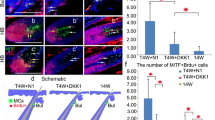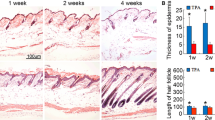Abstract
Hair follicle melanocyte stem cells (McSCs) are responsible for hair pigmentation and also function as a major melanocyte reservoir for epidermal pigmentation. However, the molecular mechanism promoting McSCs for epidermal pigmentation remains elusive. 12-O-tetradecanoylphorbol-13-acetate (TPA) mimics key signaling involved in melanocyte growth, migration and differentiation. We therefore investigated the molecular basis for the contribution of hair follicle McSCs to epidermal pigmentation using the TPA induction model. We found that repetitive TPA treatment of female C57BL/6 mouse dorsal skin induced epidermal pigmentation by increasing the number of epidermal melanocytes. Particularly, TPA treatment induced McSCs to initiate proliferation, exit the stem cell niche and differentiate. We also demonstrated that TPA promotes melanoblast migration and differentiation in vitro. At the molecular level, TPA treatment induced robust expression of stem cell factor (SCF) in keratinocytes and c-kit in melanoblasts and melanocytes. Administration of ACK2, a neutralizing antibody against the Kit receptor, suppressed mouse epidermal pigmentation, decreased the number of epidermal melanocytes, and inhibited melanoblast migration. Taken together, our data demonstrate that TPA promotes the expansion, migration and differentiation of hair follicle McSCs for mouse epidermal pigmentation. SCF/c-kit signaling was required for TPA-induced migration and differentiation of hair follicle melanocytes. Our findings may provide an excellent model to investigate the signaling mechanisms regulating epidermal pigmentation from mouse hair follicle McSCs, and a potential therapeutic option for skin pigmentation disorders.








Similar content being viewed by others
References
Arita Y, Santiago-Schwarz F, Coppock DL (2000) Survival mechanisms induced by 12-O-tetradecanoylphorbol-13-acetate in normal human melanocytes include inhibition of apoptosis and increased Bcl-2 expression. Melanoma Res 10:412–420
Botchkareva NV, Khlgatian M, Longley BJ, Botchkarev VA, Gilchrest BA (2001) SCF/c-kit signaling is required for cyclic regeneration of the hair pigmentation unit. FASEB J 15:645–658
Braun KM, Niemann C, Jensen UB, Sundberg JP, Silva-Vargas V, Watt FM (2003) Manipulation of stem cell proliferation and lineage commitment: visualisation of label-retaining cells in wholemounts of mouse epidermis. Development 130:5241–5255
Cable J, Jackson IJ, Steel KP (1995) Mutations at the W locus affect survival of neural crest-derived melanocytes in the mouse. Mech Dev 50:139–150
Chao-Hsing KA, Hsin-Su YU (1991) A study of the effects of phorbol 12-myristate-13-acetate on cell differentiation of pure human melanocytes in vitro. Arch Dermatol Res 283:119–124
Chou WC, Takeo M, Rabbani P, Hu H, Lee W, Chung YR, Carucci J, Overbeek P, Ito M (2013) Direct migration of follicular melanocyte stem cells to the epidermis after wounding or UVB irradiation is dependent on Mc1r signaling. Nat Med 19:924–929
Cichocki M, Dalek M, Szamalek M, Baer-Dubowska W (2014) Naturally occurring phenolic acids modulate TPA-induced activation of EGFR, AP-1, and STATs in mouse epidermis. Nutr Cancer 66:308–314
Cui J, Shen LY, Wang GC (1991) Role of hair follicles in the repigmentation of vitiligo. J Investig Dermatol 97:410–416
Czajkowski R, Pokrywczynska M, Placek W, Zegarska B, Tadrowski T, Drewa T (2010) Transplantation of cultured autologous melanocytes: hope or danger? Cell Transplant 19:639–643
Falabella R (2009) Vitiligo and the melanocyte reservoir. Indian J Dermatol 54:313–318
Falabella R, Barona MI (2009) Update on skin repigmentation therapies in vitiligo. Pigment Cell Melanoma Res 22:42–65
Galli SJ, Zsebo KM, Geissler EN (1994) The kit ligand, stem cell factor. Adv Immunol 55:1–96
Grichnik JM, Burch JA, Burchette J, Shea CR (1998) The SCF/KIT pathway plays a critical role in the control of normal human melanocyte homeostasis. J Investig Dermatol 111:233–238
Gu Q, Tan M, Sun Y (2007) SAG/ROC2/Rbx2 is a novel activator protein-1 target that promotes c-Jun degradation and inhibits 12-O-tetradecanoylphorbol-13-acetate-induced neoplastic transformation. Cancer Res 67:3616–3625
Guo H, Yang K, Deng F, Ye J, Xing Y, Li Y, Lian X, Yang T (2012) Wnt3a promotes melanin synthesis of mouse hair follicle melanocytes. Biochem Biophys Res Commun 420:799–804
Hachiya A, Kobayashi A, Ohuchi A, Takema Y, Imokawa G (2001) The paracrine role of stem cell factor/c-kit signaling in the activation of human melanocytes in ultraviolet-B-induced pigmentation. J Investig Dermatol 116:578–586
Hachiya A, Sriwiriyanont P, Kobayashi T, Nagasawa A, Yoshida H, Ohuchi A, Kitahara T, Visscher MO, Takema Y, Tsuboi R, Boissy RE (2009) Stem cell factor-KIT signalling plays a pivotal role in regulating pigmentation in mammalian hair. J Pathol 218:30–39
Hara M, Yaar M, Gilchrest BA (1995) Endothelin-1 of keratinocyte origin is a mediator of melanocyte dendricity. J Investig Dermatol 105:744–748
Ito K, Morita T, Sieber-Blum M (1993) In vitro clonal analysis of mouse neural crest development. Dev Biol 157:517–525
Ito M, Kawa Y, Ono H, Okura M, Baba T, Kubota Y, Nishikawa SI, Mizoguchi M (1999) Removal of stem cell factor or addition of monoclonal anti-c-KIT antibody induces apoptosis in murine melanocyte precursors. J Investig Dermatol 112:796–801
Jeon S, Kim NH, Kim JY, Lee AY (2009) Stem cell factor induces ERM proteins phosphorylation through PI3K activation to mediate melanocyte proliferation and migration. Pigment Cell Melanoma Res 22:77–85
Jiao X, Katiyar S, Willmarth NE, Liu M, Ma X, Flomenberg N, Lisanti MP, Pestell RG (2010) c-Jun induces mammary epithelial cellular invasion and breast cancer stem cell expansion. J Biol Chem 285:8218–8226
Kim MY, Choi TY, Kim JH, Lee JH, Kim JG, Sohn KC, Yoon KS, Kim CD, Lee JH, Yoon TJ (2010) MKK6 increases the melanocyte dendricity through the regulation of Rho family GTPases. J Dermatol Sci 60:114–119
Kunisada T, Lu SZ, Yoshida H, Nishikawa S, Nishikawa S, Mizoguchi M, Hayashi S, Tyrrell L, Williams DA, Wang X, Longley BJ (1998a) Murine cutaneous mastocytosis and epidermal melanocytosis induced by keratinocyte expression of transgenic stem cell factor. J Exp Med 187:1565–1573
Kunisada T, Yoshida H, Yamazaki H, Miyamoto A, Hemmi H, Nishimura E, Shultz LD, Nishikawa S, Hayashi S (1998b) Transgene expression of steel factor in the basal layer of epidermis promotes survival, proliferation, differentiation and migration of melanocyte precursors. Development 125:2915–2923
Lee AY, Kim NH, Choi WI, Youm YH (2005) Less keratinocyte-derived factors related to more keratinocyte apoptosis in depigmented than normally pigmented suction-blistered epidermis may cause passive melanocyte death in vitiligo. J Investig Dermatol 124:976–983
Lei M, Yang T, Lai X, Bai X, Qiu W, Lian X, Yang L (2013) Upregulation of interfollicular epidermal and hair infundibulum beta-catenin expression in Gsdma3 mutant mice. Acta Histochem 115:63–69
Levy V, Lindon C, Zheng Y, Harfe BD, Morgan BA (2007) Epidermal stem cells arise from the hair follicle after wounding. FASEB J 21:1358–1366
Lin JY, Fisher DE (2007) Melanocyte biology and skin pigmentation. Nature 445:843–850
Moretti S, Spallanzani A, Amato L, Hautmann G, Gallerani I, Fabiani M, Fabbri P (2002) New insights into the pathogenesis of vitiligo: imbalance of epidermal cytokines at sites of lesions. Pigment Cell Res 15:87–92
Motro B, van der Kooy D, Rossant J, Reith A, Bernstein A (1991) Contiguous patterns of c-kit and steel expression: analysis of mutations at the W and Sl loci. Development 113:1207–1221
Nataf V, Le Douarin NM (2000) Induction of melanogenesis by tetradecanoylphorbol-13 acetate and endothelin 3 in embryonic avian peripheral nerve cultures. Pigment Cell Res 13:172–178
Nishimura EK, Jordan SA, Oshima H, Yoshida H, Osawa M, Moriyama M, Jackson IJ, Barrandon Y, Miyachi Y, Nishikawa S (2002) Dominant role of the niche in melanocyte stem-cell fate determination. Nature 416:854–860
Nishimura EK, Granter SR, Fisher DE (2005) Mechanisms of hair graying: incomplete melanocyte stem cell maintenance in the niche. Science 307:720–724
Nishimura EK, Suzuki M, Igras V, Du J, Lonning S, Miyachi Y, Roes J, Beermann F, Fisher DE (2010) Key roles for transforming growth factor beta in melanocyte stem cell maintenance. Cell Stem Cell 6:130–140
Ono H, Kawa Y, Asano M, Ito M, Takano A, Kubota Y, Matsumoto J, Mizoguchi M (1998) Development of melanocyte progenitors in murine Steel mutant neural crest explants cultured with stem cell factor, endothelin-3, or TPA. Pigment Cell Res 11:291–298
Osawa M, Egawa G, Mak SS, Moriyama M, Freter R, Yonetani S, Beermann F, Nishikawa S (2005) Molecular characterization of melanocyte stem cells in their niche. Development 132:5589–5599
Prince S, Wiggins T, Hulley PA, Kidson SH (2003) Stimulation of melanogenesis by tetradecanoylphorbol 13-acetate (TPA) in mouse melanocytes and neural crest cells. Pigment Cell Res 16:26–34
Przybyszewski J, Wang W, Au A, Perry C, Guetzko M, Koehler K, Birt DF (2010) Dietary energy restriction, in part through glucocorticoid hormones, mediates the impact of 12-O-tetradecanoylphorbol-13-acetate on jun D and fra-1 in Sencar mouse epidermis. Mol Carcinog 49:592–602
Qiu W, Lei M, Li J, Wang N, Lian X (2014) Activated Hair Follicle Stem Cells and Wnt/beta-catenin Signaling Involve in Pathnogenesis of Sebaceous Neoplasms. Int J Med Sci 11:1022–1028
Rabbani P, Takeo M, Chou W, Myung P, Bosenberg M, Chin L, Taketo MM, Ito M (2011) Coordinated activation of Wnt in epithelial and melanocyte stem cells initiates pigmented hair regeneration. Cell 145:941–955
Saha B, Singh SK, Sarkar C, Bera R, Ratha J, Tobin DJ, Bhadra R (2006) Activation of the Mitf promoter by lipid-stimulated activation of p38-stress signalling to CREB. Pigment Cell Res 19:595–605
Sharov A, Tobin DJ, Sharova TY, Atoyan R, Botchkarev VA (2005) Changes in different melanocyte populations during hair follicle involution (catagen). J Investig Dermatol 125:1259–1267
Stavroulaki M, Kardassis D, Chatzaki E, Sakellaris G, Lindschau C, Haller H, Tosca A, Krasagakis K (2008) Exposure of normal human melanocytes to a tumor promoting phorbol ester reverses growth suppression by transforming growth factor beta. J Cell Physiol 214:363–370
Steingrimsson E, Copeland NG, Jenkins NA (2005) Melanocyte stem cell maintenance and hair graying. Cell 121:9–12
Tanimura S, Tadokoro Y, Inomata K, Binh NT, Nishie W, Yamazaki S, Nakauchi H, Tanaka Y, McMillan JR, Sawamura D, Yancey K, Shimizu H, Nishimura EK (2011) Hair follicle stem cells provide a functional niche for melanocyte stem cells. Cell Stem Cell 8:177–187
Wang DG, Xu XH, Ma HJ, Li CR, Yue XZ, Gao J, Zhu WY (2013) Stem cell factor combined with matrix proteins regulates the attachment and migration of melanocyte precursors of human hair follicles in vitro. Biol Pharm Bull 36:1317–1325
Wehrle-Haller B, Weston JA (1995) Soluble and cell-bound forms of steel factor activity play distinct roles in melanocyte precursor dispersal and survival on the lateral neural crest migration pathway. Development 121:731–742
Widlund HR, Fisher DE (2003) Microphthalamia-associated transcription factor: a critical regulator of pigment cell development and survival. Oncogene 22:3035–3041
Yang K, Chen J, Jiang W, Huang E, Cui J, Kim SH, Hu N, Liu H, Zhang W, Li R, Chen X, Kong Y, Zhang J, Wang J, Wang L, Shen J, Luu HH, Haydon RC, Lian X, Yang T, He TC (2012) Conditional immortalization establishes a repertoire of mouse melanocyte progenitors with distinct melanogenic differentiation potential. J Investig Dermatol 132:2479–2483
Acknowledgements
This work was supported by grants from the National Nature Science Foundation of China (Grant number: 31170924, 30972645). We thank Dr. Randall B. Widelitz (University of Southern California) for carefully revising the manuscript.
Author information
Authors and Affiliations
Corresponding author
Rights and permissions
About this article
Cite this article
Qiu, W., Yang, K., Lei, M. et al. SCF/c-kit signaling is required in 12-O-tetradecanoylphorbol-13-acetate-induced migration and differentiation of hair follicle melanocytes for epidermal pigmentation. Cell Tissue Res 360, 333–346 (2015). https://doi.org/10.1007/s00441-014-2101-8
Received:
Accepted:
Published:
Issue Date:
DOI: https://doi.org/10.1007/s00441-014-2101-8




